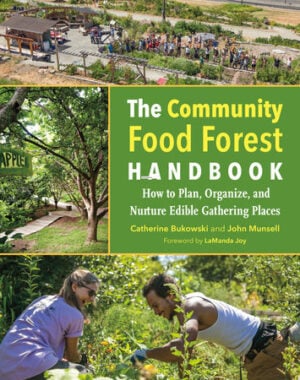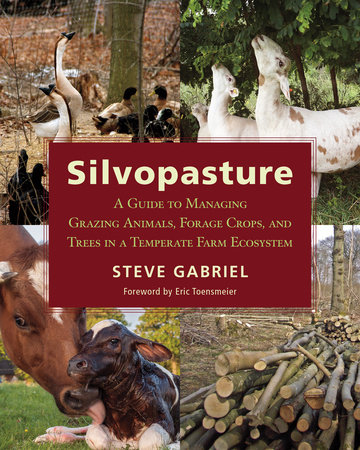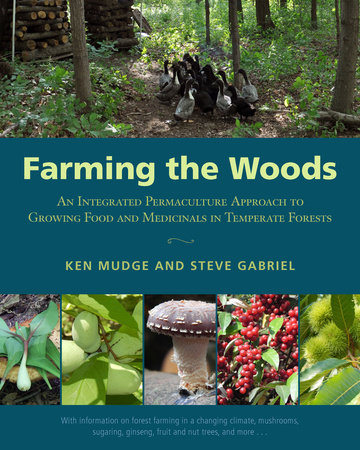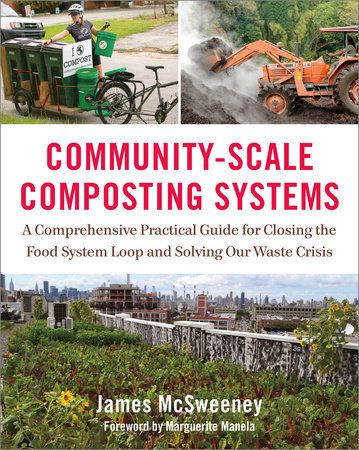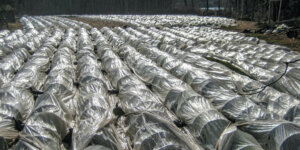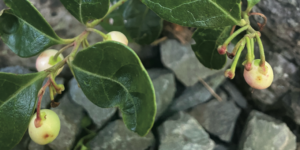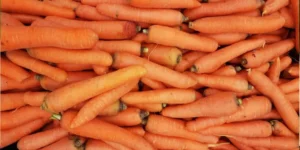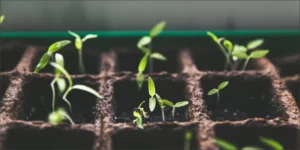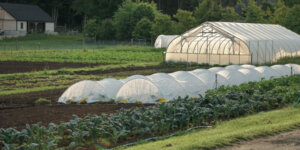An Edible Urban Oasis
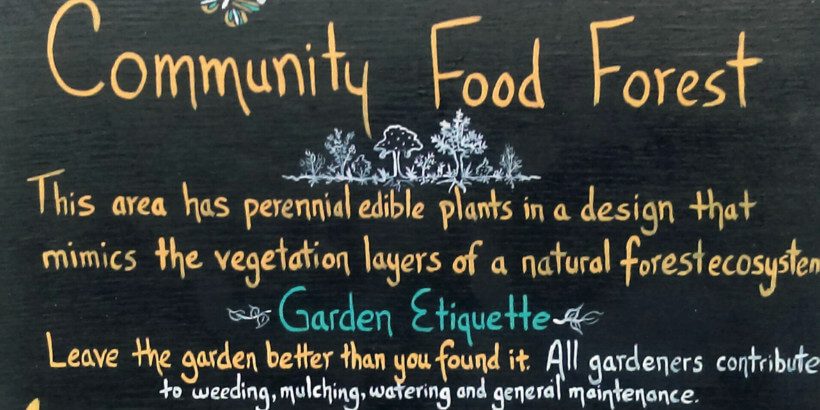
More than 80 percent of the US population now resides in urban areas. This number is projected to rise in the next few decades. Finding ways to maximize use of existing open space is imperative, and increasing access to food through sustainable management of edible landscaping is one important approach among many that are underway. Community food forests have great potential in this regard because they serve multiple functions on one piece of land. So let’s take a look at what that could look like.
The following excerpt is from The Community Food Forest Handbook by Catherine Bukowski and John Munsell. It has been adapted for the web.
The weather report called for a clear and sunny day in the low 80s. Yet it feels more like a sweltering 95°F on the sidewalk where you are standing, watching heat radiate up from the concrete. You are parched and wish there was a corner store where you could buy something cold to drink. You would love to sit down, but there are no benches. Instead, you start walking. You come to a basketball court that has bleachers, but the sun-soaked metal is hot and uninviting. You keep moving, passing vacant buildings and unkempt lots—one is overflowing with abandoned cars.
On the other side of the lot, you see rich greenery. Between a vacant building and the auto salvage yard, you find a space bursting with life. It looks like a small park, but instead of a manicured lawn, there are thick layers of vegetation and a mulched pathway heading into a jungle of trees, shrubs, flowers, and herbs. You can see cucumbers hanging off a vine and what looks like asparagus sprouting from the ground. Various plants with beautiful yellow, purple, and white flowers stand out against the green backdrop. You notice that the path splits, and one fork leads to a sign by a picnic table. Curious, you enter and sit down on the picnic bench.
![]() Plants have grown over the sign, but some of it is still visible. You read that this place is a community food forest. You are not sure what that means, but you are glad you found it. The sign says to harvest what you want and leave some for others. As you look around and take in the scene, there is a dazzling array of textures and forms in the verdant landscape. Wandering around, you find a bench under the shade of a tree, which is bursting with ripe peaches. Picking one seems like trespassing or taking something that is not yours, but they look delicious and there are plenty. You glance around, wondering, is this a test? But the sign says harvesting the fruit is welcome, so why not?
Plants have grown over the sign, but some of it is still visible. You read that this place is a community food forest. You are not sure what that means, but you are glad you found it. The sign says to harvest what you want and leave some for others. As you look around and take in the scene, there is a dazzling array of textures and forms in the verdant landscape. Wandering around, you find a bench under the shade of a tree, which is bursting with ripe peaches. Picking one seems like trespassing or taking something that is not yours, but they look delicious and there are plenty. You glance around, wondering, is this a test? But the sign says harvesting the fruit is welcome, so why not?
Biting into the juicy sweetness of the fruit is a heavenly escape. You begin to relax as you become aware of chirping birds and notice butterflies and bees busy at work. Now that you are tuned in, these sounds of nature overtake the urban hum-drum. This place is pulsing with life.
You spot a patch of sunflowers, rows of corn, and a pear tree cleverly situated to screen the view of the neighboring car lot. Underneath the tree is a mixture of herbs and knee-high plants. Nearby, ripe raspberries delicately hang from a branch reaching into a sunlit patch. You pick a pear to eat and continue meandering along the path, watching insects of many kinds pollinating flowers. Delightful smells swirl about as you step on some of the herb plants underfoot.
The sensory experience full of vibrant colors, tastes, smells, and textures has replenished you. You feel relaxed, yet energized and intrigued. The sign described this place as a community food forest, but what exactly is that? It resembles a young forest, but it is unlike any community garden or park you have seen before. Why would someone create something like this and leave it open to the public? Who looks after this place? How can you learn more about it? Are there other places like this? Is there one in or near your community, and if so, how can you get involved? With these questions buzzing in your brain, you walk back out into the city street.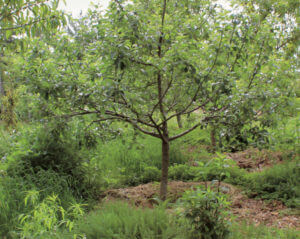
What is a Community Food Forest?
The definition of a community food forest differs depending on whether the focus is on the concept or the physical space. Conceptually, to better understand the meaning embedded in the term community food forest, consider each word: forest, food, and community. Forests are places, but forests become social spaces through physical, cultural, environmental, and emotional connections. One such connection is food, which can bring people together, but others such as dialogue, wildlife, and recreation are also important. When people connect in forested spaces, they shape their social sense of place, values, and identity and create community. Thus, concepts of environment and society are critical pieces of a community food forest, because both influence actions like planning, planting, and maintenance that transform ideas into real projects.
An on-the-ground, physical food forest mimics the spatial and functional patterns of a naturally occurring forest ecosystem. Most people think of a forest as a large area, but from a biological standpoint, a forest does not have to meet a minimum height or size requirement.
Rather, the term food forest signifies a highly integrated community of plants that has various vertical and horizontal plant and root layers that provide edible products.
Modeling the structure of a young forest ecosystem in public places is ideal for two reasons
First, planting multiple perennial species in close proximity can sustainably yield food in confined areas, which can help meet the growing global demand for nutritious production. Second, as the vegetation matures, it can create a forested park-like setting, providing a pleasing natural space where community members can gather. Even if food production in a community food forest decreases, the forest still provides valuable green space in built environments.
Recommended Reads
Recent Articles
Want to grow year-round, but a greenhouse feels like a big investment? When it comes to cost and flexibility, low tunnels are the all-around winners.
Read MoreWintergreen is the stunning evergreen groundcover that’s a game-changer for your garden! It’s cherished for its aromatic leaves, vibrant fall color & bright berries.
Read MoreGrow winter carrots for a sweeter & more flavorful harvest! Ditch the bland, store-bought carrots this winter! Grow your own winter carrots for a sweeter and more flavorful twist 🥕🥕
Read MoreSearching for the perfect book to give the homesteader in your life? We’ve got your go-to books for anyone interested in organic growing, permaculture, soil health, year-round growing & more! What’s their next great read?
Read MoreWinter is coming… but that doesn’t mean you should put away those tools just yet. Extend the growing season well past the first frost!
Read More

